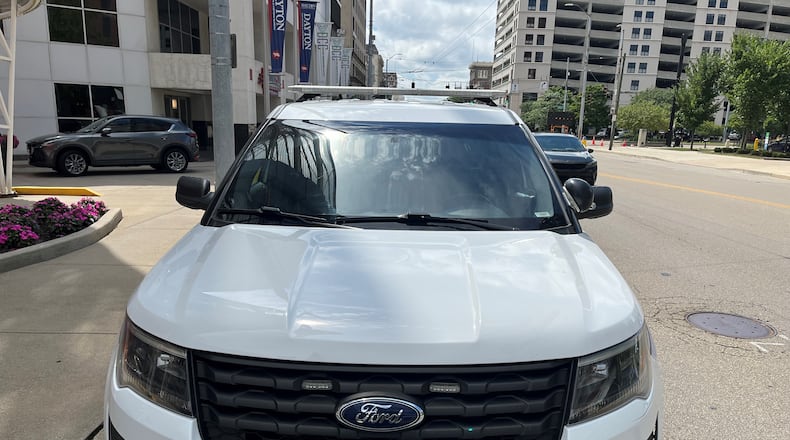Debate about the devices — whether stationary or mobile — also continues.
Advocates say ALPRs are critical in helping solve crimes in various area local jurisdictions, across Ohio and sometimes nationally. But opponents, like the Ohio ACLU, counter that their use without proper state or local laws is “highly irresponsible,” can invade privacy and invite abuse.
Kettering is one of more than a dozen area cities using stationary license plate readers. It plans to take the concept mobile as that capability will be part of 30 in-cruiser cameras set to be installed this spring.
The $1.7 million, five-year deal that includes new body-worn cams and upgraded tasers, Kettering Police Chief Chip Protsman said, is the largest one-time equipment purchase in his nine-year tenure.
The in-cruiser cameras can scan license plates and issue alerts if the vehicles have been reported stolen, were connected to other crimes or their registered owners are wanted on felony or domestic violence warrants, police have said.
Growing police usage
Kettering, which has 10 stationary cameras, is the only area police department committing to installing the in-cruiser cameras this year, according to DDN survey responses from 18 communities in Greene, Miami, Montgomery and Warren counties.
The popularity of the mobile and the stationary technology has grown nationally in recent years. More than 2,000 law enforcement agencies work with Flock Safety, according to the Atlanta-based business.
Among those employing stationary devices are Bellbrook, Beavercreek, Centerville, Franklin, Huber Heights, Miamisburg, Miami Twp., Springboro, Tipp City and Vandalia.
Dayton and Kettering police said the ALPRs have been invaluable in helping solve crimes.
“I can’t tell you how effective those Flock cameras have been for us,” Protsman said. “I know there’s some concern when people around the county started getting them. But that has really helped us solve a lot of crimes … The opportunity to have 30 more of these cameras and having them mobile is a real asset to us.”
Since July 2022, Kettering police have cited the Flock cameras as assisting in apprehending at least 28 suspects, city records show.
In Dayton, police credited the devices for four arrests in three specific cases since Dec. 12. Those crimes involved two aggravated robberies at Family Dollar stores, a robbery at a McDonald’s and a domestic violence issue, DPD spokesman James Rider said in the survey.
“It is impossible to count the number of times this technology has assisted in investigations,” Rider said.
Technology pros and cons
Before the Dayton City Commission voted 3-2 to approve the mobile cameras, some residents objected, saying they can be misused or result in over-policing.
“Transparency and accountability should remain the standard, not just for the general population, but for those that lead and also protect,” Dayton resident Barbara Thomas said at the time.
Protsman said last week that “the public wants transparency and for us to offer up and show what the officers are doing is invaluable to us now.
“It’s invaluable to have for training,” he added. “And it has certainly been an opportunity that when people ask questions — or accusations are made against officers — for us to go back and look at that and have a very good understanding of what happened.”
Miamisburg, Riverside and Springboro all cited funding constraints as to why they either have not activated the mobile technology or no longer use it, according to survey responses.
By bundling the equipment purchases, Kettering’s deal with Axon Enterprises Inc., the business with which Dayton also contracted for mobile units, is estimated to save about $500,000 over the five years, Protsman said.
The deal includes more than 85 body-worn cameras and about 95 tasers, he said, but the in-cruiser cams will be the most significant change.
“We’re not looking at this for citizens who are just driving to work,” Protsman said. “We’re using this for people who are involved in criminal activity.
“Taxpayers want to be aware that we’re taking action against those people and these cameras are a tool for us to do that,” he added.
Technology upgrades used by law enforcement “won’t end” with mobile license plate readers, said Gary Daniels, chief lobbyist for the Ohio American Civil Liberties Union.
“This is the path of all surveillance technology used by government,” he added. “There’s absolutely nothing out there governing their use as far as (state) law goes.”
Protsman has said his department has developed policies to address proper usage by Kettering law enforcement and violators would face termination.
But local policies “have no force of law,” Daniels said. “There’s no accountability there except for internal accountability — assuming that the policy does contain some sort of internal accountability. Just having a policy, that doesn’t cut it.”
Staff Writers Cornelius Frolik, London Bishop, Nancy Bowman, Aimee Hancock, Ed Richter and Eric Schwartzberg contributed to this report.
About the Author


